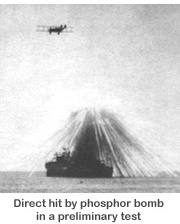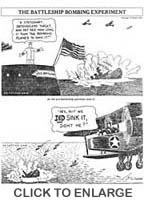
The Day That Mere Airplanes
Changed the Future of Sea War
 In 1921 the German battleship Ostfriesland, a prize of war, was sunk by bombs dropped by Army planes in the last of a series of tests to determine the effectiveness of air weapons against ships and the means by which ship design and construction might counter their destructive capability. In 1921 the German battleship Ostfriesland, a prize of war, was sunk by bombs dropped by Army planes in the last of a series of tests to determine the effectiveness of air weapons against ships and the means by which ship design and construction might counter their destructive capability.

The tests, in which the Army participated at the invitation of the Navy, brought about by insistence from USAAC General William "Billy" Mitchell, were carried out off the Virginia Capes beginning June 21. That day the German submarine U-117 was sunk by 12 bombs dropped from Navy F-5Ls at 1100 feet. On June 29 USN aircraft located the radio-controlled US battleship ex-Iowa in one hour and 57 minutes after being alerted of its approach "somewhere" within a 25,000-square mile area, and attacked with inert bombs. On July 13 Army bombers sank the German destroyer G-102, and on July 18 the German light cruiser Frankfurt went down under the combined effect of 74 bombs delivered by Army and Navy aircraft.

In February 1921 at the urging of Mitchell, who was anxious to test his theories of destroying ships with Army planes, Secretary of War Newton Baker and Secretary of the Navy Josephus Daniels agreed to a series of joint Army-Navy exercises, known as Project B, in which surplus or captured ships could be used as targets.

Mitchell was concerned that building battleships diverted precious defense dollars away from military aviation. His contention was that a force of airplanes could defend a coastline with more economy than combined coastal guns and naval vessels—a thousand bombers could  be built for the same price as one battleship, and they could sink that battleship. He infuriated the Navy by claiming he could sink ships "under war conditions" and boasted that he would prove it if he was allowed to bomb some captured German warships. be built for the same price as one battleship, and they could sink that battleship. He infuriated the Navy by claiming he could sink ships "under war conditions" and boasted that he would prove it if he was allowed to bomb some captured German warships.

The Navy finally reluctantly agreed to the demonstration after news leaked about its own tests—to counter Mitchell the Navy had sunk the old battleship Indiana on 1 November 1920 using its own airplanes. Daniels had hoped to squelch Mitchell with a report on the results by Capt William Leahy: "The entire experiment pointed to the improbability of a modern battleship being either destroyed or completely put out of action by aerial bombs." When the New York Tribune revealed that the Navy's "tests" used dummy sand bombs and that the ship was actually sunk using high explosives placed aboard it, Congress urged new tests.

For those tests there was to be a news blackout until all data had been analyzed, then an official report released, but Mitchell suspected the Navy would color the results. The Chief of the Air Corps moved to have Mitchell dismissed a week before the tests, reacting to Navy complaints about his criticisms, but the new Secretary of War John Weeks backed down in the face of Mitchell's widespread public and media support.

On 20 July the Navy offered the Ostfriesland, considered unsinkable. One day of scheduled 230- to 600-lb bomb attacks by Marine, Navy, and Army aircraft settled Ostfriesland three feet by the stern with a five degree list to port—it was taking on water.


Further bombing was delayed a day when the Navy claimed rough seas prevented their Board of Observers from going aboard. The Air Service contested that as their bombers approached. They were ordered not to attack and had to circle for 47 minutes before receiving approval, then dropped only their small bombs.

On the morning of July 21, in accordance with an orchestrated schedule of attacks led by Army Lt Clayton Bissell, five Martin NBS-1s each dropped a 1100-lb bomb, scoring three direct hits. The Navy than stopped further drops to assess damage, although the Army bombers had nine bombs remaining. By noon the Ostfriesland had settled two more feet by the stern and one foot by the bow. orchestrated schedule of attacks led by Army Lt Clayton Bissell, five Martin NBS-1s each dropped a 1100-lb bomb, scoring three direct hits. The Navy than stopped further drops to assess damage, although the Army bombers had nine bombs remaining. By noon the Ostfriesland had settled two more feet by the stern and one foot by the bow.

At that point, 2000-lb bombs were loaded for a flight of two Handley-Page O/400s and six NBS-1s. One O/400 fell out for mechanical reasons, but the NBS-1s dropped six bombs in quick succession between 12:18 and 12:31 pm, aiming for the water close to the ship. Three of the bombs were close enough to rip hull plates and cause the ship to roll over. It sank at 12:40, 22 minutes after the first bomb. In a wry salute, a seventh bomb was dropped by the O/400 on the foam rising from the doomed ship.

|